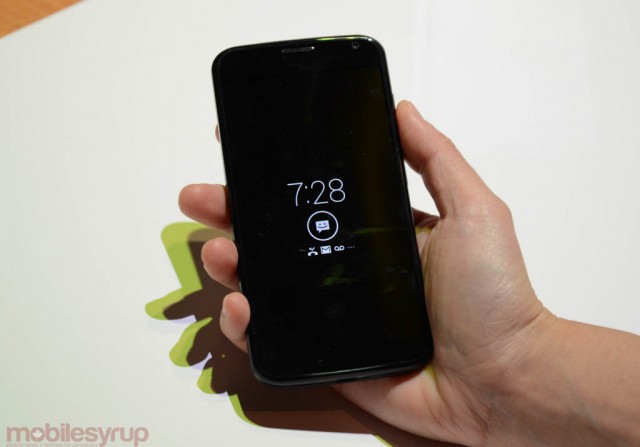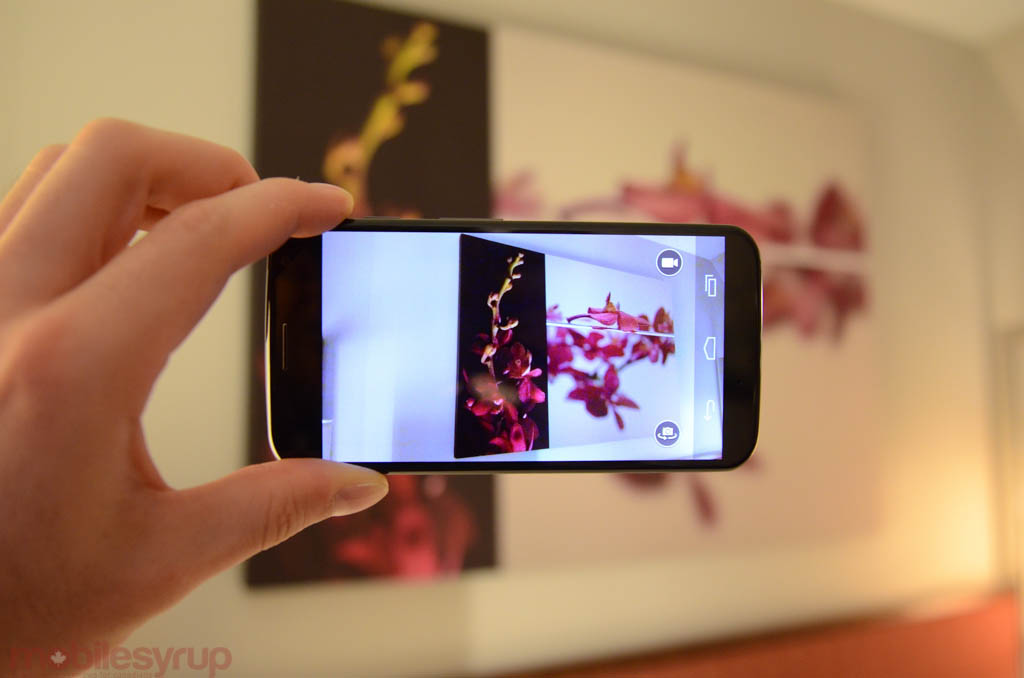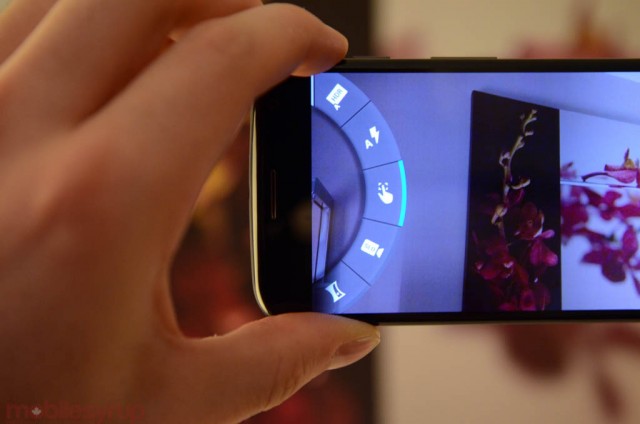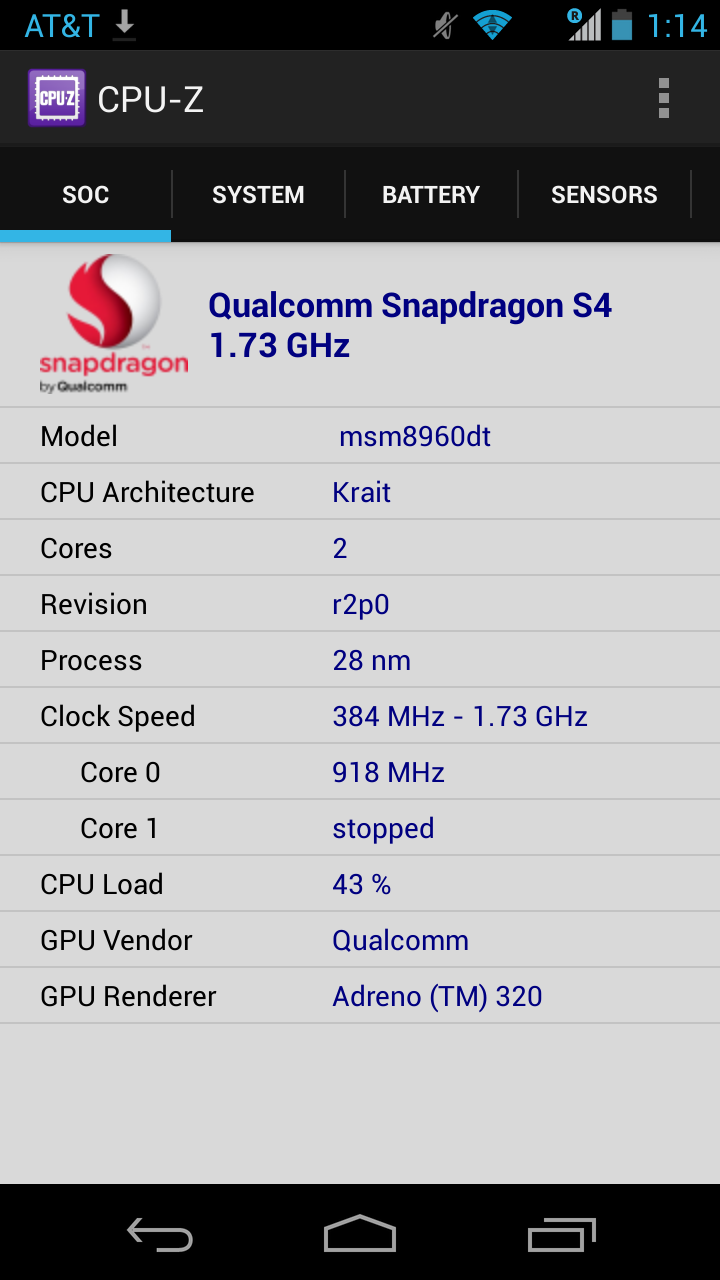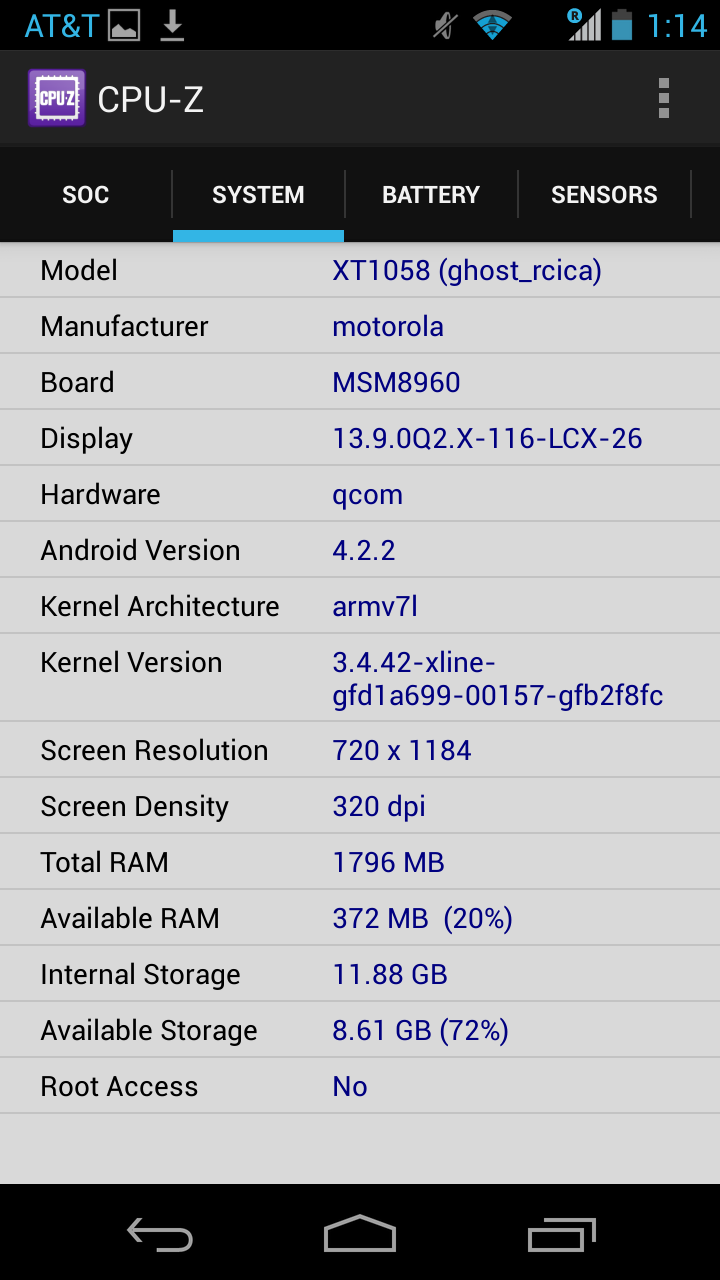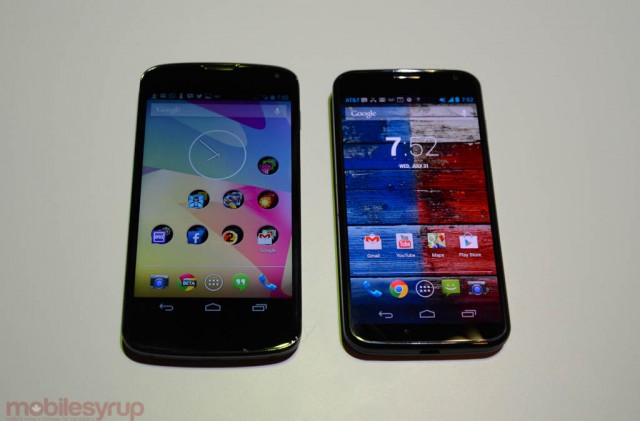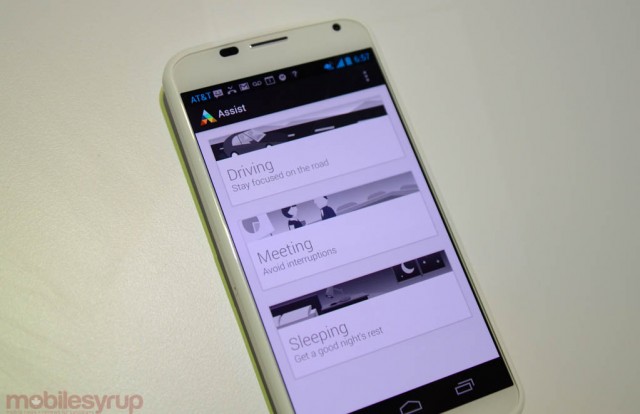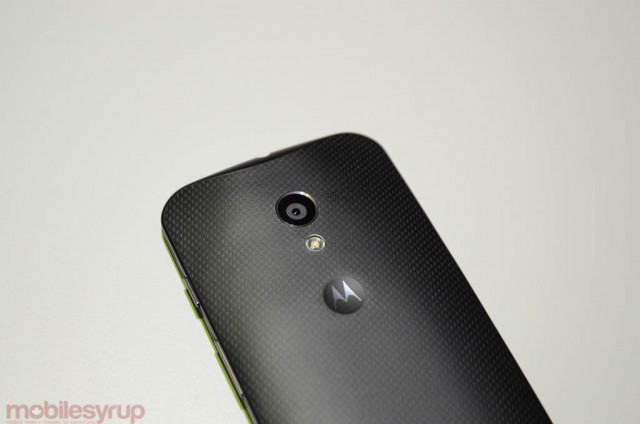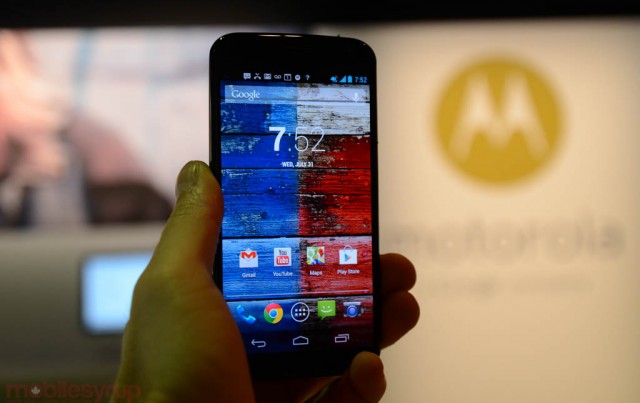

At long last, and after much anticipation, Moto X is finally here.
First, let’s get the short stuff out of the way. Yes, it will be exclusive to Rogers in Canada; and yes, it will lack the personalization options of its US counterparts, coming in white or black in 16GB varieties only for $189.99 on a 2-year term. There is no outright price just yet. OK, now that’s out of the way, let’s continue.
A Tightness in the Bezel
Moto X is a really interesting smartphone. It doesn’t try to do anything louder or bigger than its counterparts; you can see a lot of care went into making it compact, holistic and quiet. This unassuming combination of polycarbonate, whose ribbed texture belies a smooth surface, and wrapped glass, feels just right in the hand, a testament to Motorola’s insistence that device size trumps screen size.
To that end, the newly-taut company — there are just over 4,000 employees compares to 20,000 when Google acquired them in 2011 — worked together across divisions to design a phone that users could use in one hand, but maintained the screen size of a modern handset. They settled with a 4.7-inch 1280×720 pixel OLED display, but you’d be forgiven for mistaking the phone for a 4.3-inch wonder. There is almost no bezel to speak of, and the device features a curved, feline back that settles in your palm like a much-loved baseball glove.
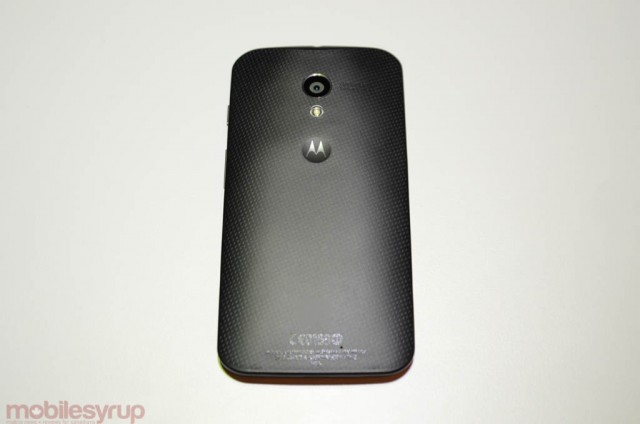
You start with the compactness, but Moto X comes fully-formed, in a way I could only describe top-tier devices like the iPhone 5 or HTC One. Created from two pieces of resined polycarbonate, Motorola is quick to assure us that this is one of the strongest, most durable materials one can find on a phone today. It certainly feels sturdy, and lacks the oversized flagship nature of its Samsung and HTC counterparts.
A few more touches differentiate the hardware from the rest of the Android rabble: its X8 chip is custom-designed to ensure optimal battery life and top-notch performance, but when you dig deeper you realize that Motorola has merely repurposed one of the industry’s most efficient SoCs. Inside the X8 is a dual-core Qualcomm Snapdragon MSM8960T processor clocked at 1.7Ghz. This means that there are two Krait 300 cores clocked at 1.7Ghz and an Adreno 320 GPU, likely clocked at 400Mhz. But Motorola has also appended two chips, one for context and one for sound, to enable three device-specific features that we’ll get to next.
It’s not quite the bespoke solution Motorola is claiming — they didn’t custom-design the chip, for instance — but they felt that due to Android’s GPU-heavy workflow, it was more important to have two CPU cores working efficiently and a powerful GPU shouldering the brunt of the acceleration than waste die space on a four-core CPU solution that wouldn’t be fully utilized. It’s certainly a gambit, especially in a market feverish for “feeds and speeds,” but Motorola’s close proximity to Google, and its insistence on using stock Android, will ensure a universally good software experience.
The rest of the specs sheet reads like that of a decent mid-range device. We have five antennas, four specifically to power the 3G and 4G baseband; multi-band WiFi including Wireless AC; NFC, GPS and GLONASS; 50GB of Google Drive storage for two years; and Miracast for wireless mirroring. No wireless charging, unfortunately.
See And Be Seen
One of the most interesting divergences from the traditional Android workflow is the addition of Active Notifications, a replacement for the contextless flashing red or white light.
When you receive a notification on Moto X, the screen, which is OLED and designed to sip power and only light necessary pixels, will display the apps in need of attention. Tapping on the icon will either give you a preview of the content or quickly usher you into the app itself. Using proximity and light sensors, Moto X knows when the phone is in your pocket or turned over, and will quickly alight with updated information when you first look at it.
It’s Motorola’s interpretation of the notification light, and it works well specifically because they are careful in how they array the information. You can customize the number of apps, as well as the content within those apps, that is shown on the screen, and the phone goes back to sleep with a gentle breath after a moment. Practically any notification that you’d see in the standard status bar, from a Tweet to Maps directions, are available.
Gestures and a Smart Camera
Motorola’s study of how people used their phones led them to incorporating a quick wrist-snapping gesture to activate the camera when the Moto X isn’t turned on. Using those context-aware sensors, Motorola can detect when users perform specific gestures, such as twisting your wrist back and forth twice, to activate things such as the camera.
It takes some getting used to, but as a Moto rep predicted, I got the hang of the motion fairly quickly. It may not feel intuitive at first, but you’re not trying to win a race; all it takes is a persistent, gentle persuasion.
Once inside the app itself, shooting is intuitive, similar to the one-touch workflow found in BlackBerry 10 devices. Motorola uses two more gestures, sliding from the left and from the right, to display Settings and Gallery respectively, but most users will be able to tap the screen and get a great photo.
The 10.5MP camera sensor and f/2.4 aperture lens combo is backlit, and adds a white pixel to the standard RGB Bayer makeup of the sensor. This takes in more like at faster shutter speeds, enabling blur-free photos without sacrificing exposure. In practice, this works quite well unless the room is poorly lit, and from my initial tests the results are fairly consistent with the rest of the market. This may not trounce the Galaxy S4 for features or speed, but the results are pretty much the same. Motorola ensured me that the pixel size is 1.4 microns, larger than most in the equivalent megapixel range. This promises better low-light shots.
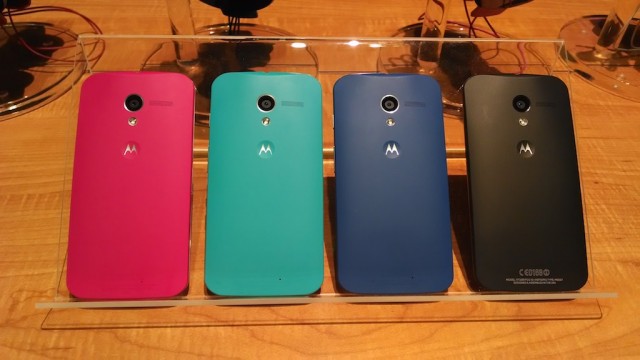

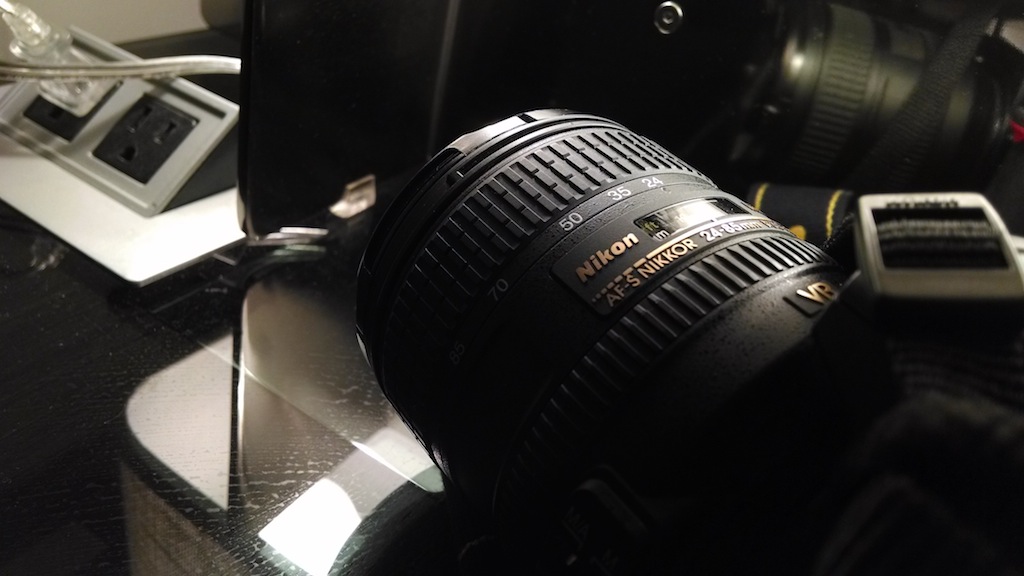
“OK, Google Now”
The last major area we’ll touch on is what Motorola is calling Touchless Controls, or voice activation. This allows you to train the Moto X to respond to your voice simply by entering a command, “OK, Google Now.”
One of the sensors included in the X8 is always listening for your voice, but the low-level chip promises not to use too much battery life. Indeed, while you can turn the feature off, we didn’t notice any deleterious effects to the battery.
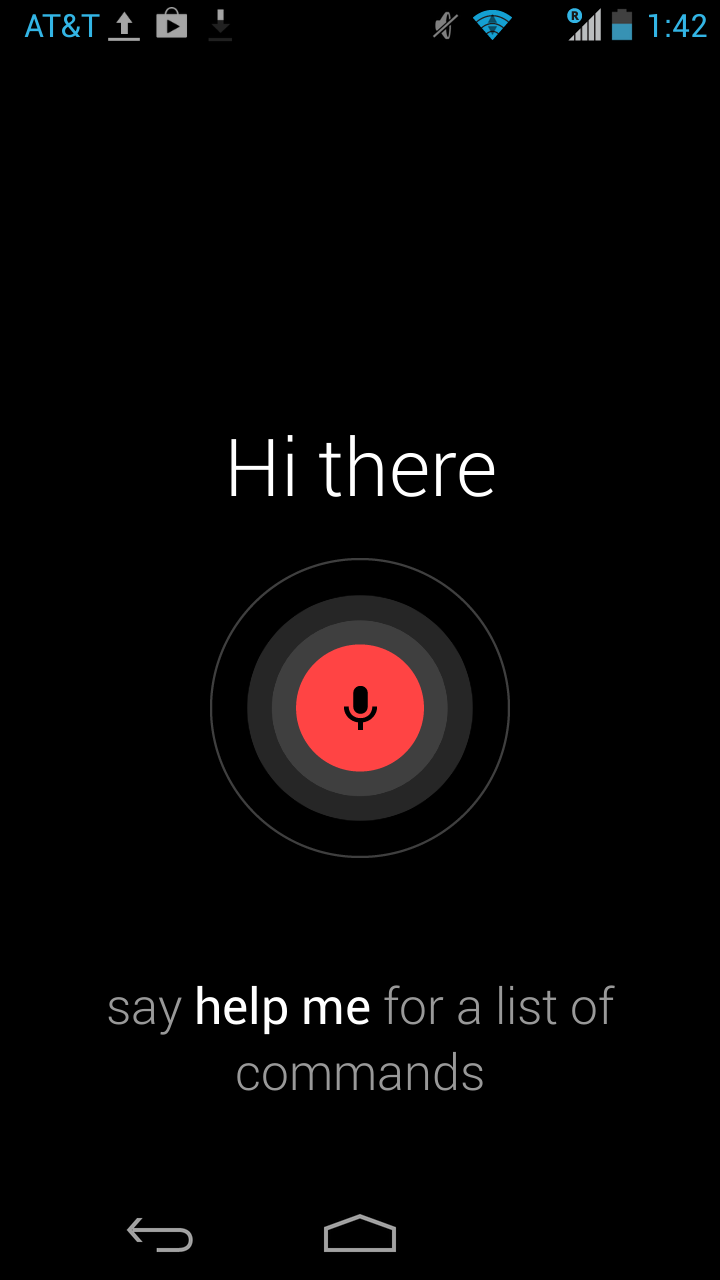

It appears that manufacturers are pulling us into the world of voice controls whether we want them or not. Siri, while not a proactive participant in iOS, is nonetheless growing in intelligence and content. Similarly, Google Now is expanding its breadth of knowledge, using Google’s Knowledge Graph and Android’s intents system as a buoy. There are times I can see myself using Moto X without touch, but many other times I’d prefer to do as I’ve always done: use my fingers.
Eat My Specs
At its core, Moto X is a fairly simple Android phone. It runs a stock version of Android 4.2.2 that, aside from some small additions (read: not changes), functions identically to the version you’d find on the Nexus 4.
The phone itself also resembles the Nexus 4, and does not run anything close to the high-end hardware we’d expect from Samsung, HTC, LG or Sony. Motorola’s VP of Product Management, Punit Soni, told me this was deliberate. There is no need, he said, to emphasize specs when the extra hardware is either not used or not appreciated by the end user. See, for example, the iPhone, which stays away from the specs race each year but manages to perform brilliantly by marrying hardware and software into a cohesive experience.
Moto X feels similar to this: Google has advanced Android to the point where it is considered quite attractive and user-friendly out of the box, and developers are iterating great apps that rival, or even surpass, their iPhone counterparts. That Moto X feels so great to use adds to the feeling that the team took what Android is and made a phone to work with it instead of other OEMs’ desire to fit Android into their idea of a phone. It often doesn’t work, but Motorola’s emphasis on simplicity works in Moto X’s favour here.
It’s difficult to understand just how much more compact the Moto X is than a typical Android smartphone unless you hold it in your hands; even photos don’t do it justice. It’s only marginally wider and taller than the iPhone 5, and significantly smaller than the already-compact Nexus 4. For users who are looking for a big screen without a bulky chassis, Moto X is pretty much your only choice.
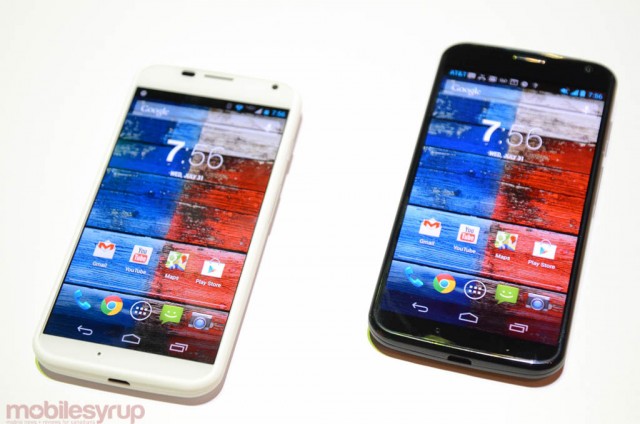 The Canadian Way
The Canadian Way
Moto X is also beginning something new in terms of phone customization and distribution, at least in the United States. MotoMaker is a program that allows, at first, AT&T buyers to alter the front colour, back colour, accents such as camera ring and volume buttons, and tag a signature on the back. In the future, it may even allow for different grains of wood to be used.
But Rogers, the exclusive Canadian partner, does not have access to this program, making the only option for us either a black or white 16GB model. This will undoubtedly be disappointing to some users, but it’s not surprising. Motorola is rolling out this program slowly, carefully, as it learns to scale up its Texas plant and ship custom phones to users within four business days. Lior Ron, another VP of Product Management at Motorola, says that users will see real-time updates on their build status, so if all the green backs are out, for instance, the delay will be immediately noted.
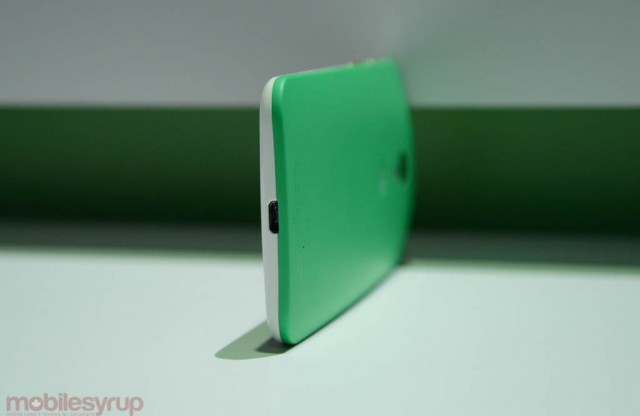
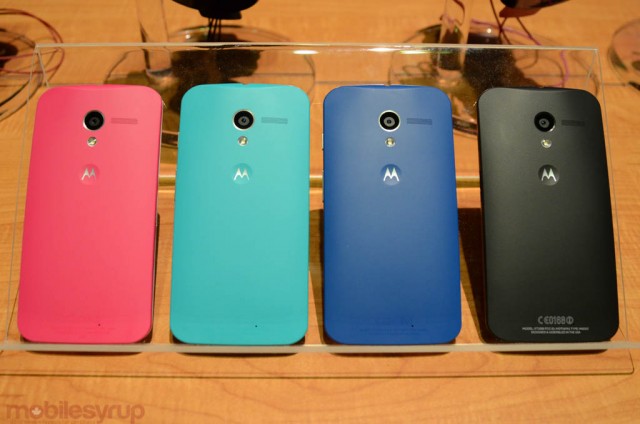 As you can see, some of the colour combinations are fantastic, and the possibilities, combined with some of the accent colours, are seemingly endless. We’ve told both Rogers and Motorola how much we want this program to come to Canada, so let’s see what happens down the road.
As you can see, some of the colour combinations are fantastic, and the possibilities, combined with some of the accent colours, are seemingly endless. We’ve told both Rogers and Motorola how much we want this program to come to Canada, so let’s see what happens down the road.
The black model, while fairly staid, is really nice to look at. The white model, on the other hand, is stunning. One can see layers between the curved Gorilla Glass on top of the display and the OLED screen underneath, but unlike in years prior, there is no gap between the display, glass and digitizer. The layering is for effect only; the OLED screen pops.
The Rest
So, is Moto X better than the Galaxy S4, HTC One or iPhone 5? Strangely, I don’t think Motorola cares. It’s trying neither to out-spec its competitors or out-sell its rivals, but is modestly re-entering the market in which it was once so dominant, and is now so different.
There is no question that Moto X is an interesting, capable device. It’s certainly the best choice for users looking for a compact Android device, and certainly a compelling alternative to the Nexus 4. It lacks the 1080p screen of the HTC One, and the camera doesn’t match the speed and quality of the GS4. Android, while it’s made significant improvements in both app quality and stability, still doesn’t quite match the iPhone. And, as you’ll find over the next few weeks, many of the features such as no-touch controls or active notifications, will be imitated and released by third-party developers for other handsets. They won’t match Motorola’s slick implementation — it takes a decent amount of hardware and software compatibility to pull it off as well as Moto has here — but they’ll arrive.
Moto has preloaded a few more apps to round out the experience. Assist, as seen above, is the evolution of SmartActions, which the company debuted with its RAZR refresh last year. Assist lets you preset certain triggers, such as a time or location, and have the phone take action, like silencing the ringer before bed or turning on WiFi when arriving at home. Migrate is a great way to transition over to Moto X from a previous Android device, as it syncs bookmarks, contacts, calendar entries, stored texts and more between the old and new phone. MotoConnect is a Chrome extension similar to Rogers One Number: it lets you see incoming calls and read and reply to incoming texts from your Chrome browser, synced over a Google account.
And Now We Wait
Moto X is coming to Rogers sometime in August, closer to the end of the month, for $189.99 on a 2-year term. There is no specific date, nor an outright price, nor a timeframe for when the company will expand its MotoMaker portal to Canadians.
After my brief time with the phone, I can tell you a few things. I really enjoy using it, from holding it in my hand to taking photos using the quick wrist action. I’ve noticed no slowdowns, nor issues loading apps or games, and I’m very pleased with Motorola’s decision to build atop stock Android rather than forging ahead with yet another skin.
I don’t care that it doesn’t have a quad-core processor or a 1080p screen, but for the price it will be difficult for Rogers to convince others of its worth. It’s a fascinating and quiet rebirth for the new Google company, and I can’t wait to see where it takes them.
MobileSyrup may earn a commission from purchases made via our links, which helps fund the journalism we provide free on our website. These links do not influence our editorial content. Support us here.

